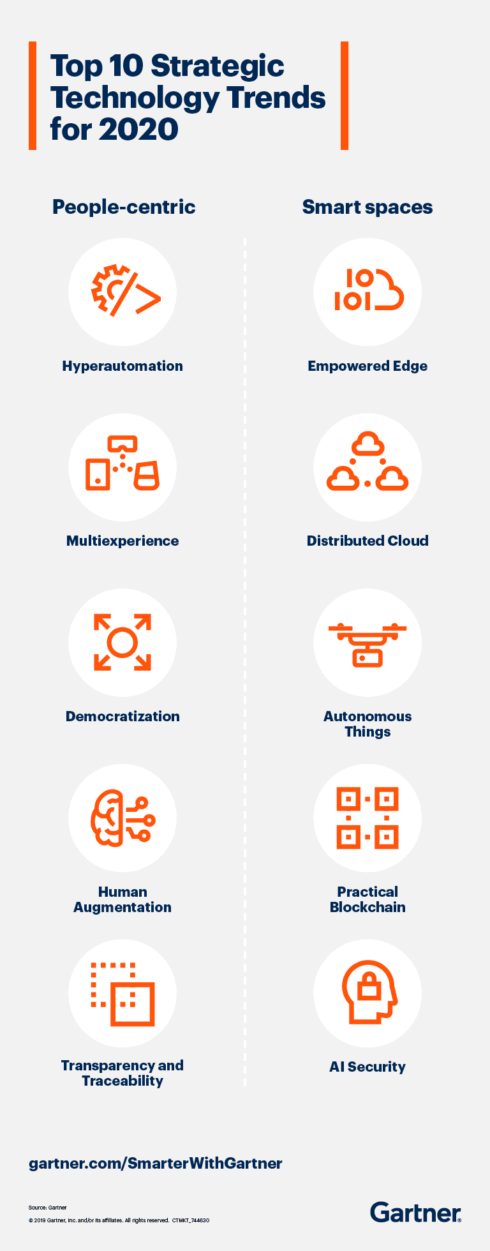
Gartner revealed its top 10 strategic technology trends for the next year at its IT Symposium/Xpo 2019 conference in Orlando.
According to the company, a strategic technology trend is one that has the potential to disrupt the industry and break out into broader impact and use.
Unlike last year’s trends, this year’s trend does not fall into intelligent, digital and mesh categories, but are instead structured around “people-centric smart spaces,” or technologies that will affect people and places they live, according to Gartner.
“These trends have a profound impact on the people and the spaces they inhabit,” said Brian Burke, Gartner Research VP. “Rather than building a technology stack and then exploring the potential applications, organizations must consider the business and human context first.”
The top 10 trends for the next year are:
1. Hyperautomation: Automation refers to solutions that can automate manual human tasks. Hyperautomation refers to automating tasks using advanced technologies such as artificial intelligence and machine learning. According to Gartner, while it can be applied to a range of tools, it often refers to discover, analyze, design, automate, measure, monitor and re-asses.
“As no single tool can replace humans, hyperautomation today involves a combination of tools, including robotic process automation (RPA), intelligent business management software (iBPMS) and AI, with a goal of increasingly AI-driven decision making,” Garter wrote in a blog post.
2. Multiexperience: Instead of technology-literate people, multiexperience addresses people-literate technology, Gartner explained. Here, computers move from single point interactions to multisensor and multitouch point interfaces such as wearable devices or advanced computer sensors.
The example the research firm gave was Domino’s Pizza going beyond app-based ordering with autonomous delivery vehicles, a way to track the pizza and smart speaker communication. Gartner predicts this will be called an ambient experience in the future, but currently focuses on immersive experiences (which ones one of Gartner’s trends for 2019) like augmented reality, mixed reality, human-machine interfaces and sensing technologies.
3. Democratization of expertise: Industry leaders are always trying to democratize a technology trend for the broader set of people. Gartner believes this will be a trend to look out in the next coming year as technology is created to provide users with easy access to technical or business expertise without going through extensive and costly training. This area will focus on four key areas: application development, data and analytics, design, and knowledge.
“For example, democratization would enable developers to generate data models without having the skills of a data scientist. They would instead rely on AI-driven development to generate code and automate testing,” Gartner wrote.
4. Human augmentation: Or technology that enhances human cognitive and physical experiences. Physical augmentation refers to:
- Sensory augmentation such as hearing, vision or perception
- Appendage and biological functions augmentation such as exoskeletons and prosthetics
- Brain augmentation such as implants to treat seizures
- Genetic augmentation such as somatic gene and cell therapy
Cognitive augmentation refers to the ability to think and make decisions such as exploiting information and applications to improve learning and experiences, according to Gartner.
5. Transparency and traceability: Building off of last year’s digital ethics and privacy trend, transparency and traceability will be prevalent throughout the next year next year.
“The evolution of technology is creating a trust crisis. As consumers become more aware of how their data is being collected and used, organizations are also recognizing the increasing liability of storing and gathering the data,” Gartner wrote. Additionally, AI and ML are increasingly used to make decisions in place of humans, evolving the trust crisis and driving the need for ideas like explainable AI and AI governance.”
This trend will focus on ethics, integrity, openness, accountability, competence and consistency.
6. The empowered edge: The empowered edge is making Gartner’s list year again as technologies like the Internet of Things continues to evolve and put information closer to the source of information. Gartner predicts by 2023, there will be 20 times as many smart devices at the edge.
“Much of the current focus on edge computing comes from the need for IoT systems to deliver disconnected or distributed capabilities into the embedded IoT world for specific industries such as manufacturing or retail,” said Burke. “However, edge computing will become a dominant factor across virtually all industries and use cases as the edge is empowered with increasingly more sophisticated and specialized compute resources and more data storage. Complex edge devices, including robots, drones, autonomous vehicles and operational systems will accelerate this shift.”
7. Distributed cloud: As cloud adoption continues to increase, Gartner is looking at distributed clouds over the next year. Distribute cloud refers to “the distribution of public cloud services to locations outside the cloud provider’s physical data center, but which are still controlled by the provider.” The cloud provider is responsible to cloud service architecture, delivery, operations governance and updates, Gartner explained.
8. Autonomous things: While autonomous things is lower on Gartner’s list this year, the research firm still expects drones, robots, ships and appliances to be big next year. The firm expects autonomous things to evolve from controlled environments to open public spaces.
“As autonomous things proliferate, we expect a shift from stand-alone intelligent things to a swarm of collaborative intelligent things where multiple devices will work together, either independently of people or with human input,” said Burke. “For example, heterogeneous robots can operate in a coordinated assembly process. In the delivery market, the most effective solution may be to use an autonomous vehicle to move packages to the target area. Robots and drones aboard the vehicle could then affect final delivery of the package.”
9. Practical blockchain: Blockchain has been a part of Gartner’s top 10 list for a number of years now, but the firm expects it to go from experimental to fully scalable by 2023. The complete blockchain model will include:
- A shared and distributed ledger
- Immutable and traceable ledger
- Encryption
- Tokenization
- A distributed public consensus mechanism
“Blockchain remains immature for enterprise deployments due to a range of technical issues including poor scalability and interoperability. Despite these challenges, the significant potential for disruption and revenue generation means organizations should begin evaluating blockchain, even if they don’t anticipate aggressive adoption of the technologies in the near term,” said Burke.
10. AI security: Instead of AI-driven development, this year Gartner it keeping a close eye on AI security. Hyperautomation and autonomous things will not only introduce new opportunities, but new potential points of attacks, according to Gartner. AI security includes: protecting AI-powered systems, leveraging AI to enhance security defense; and anticipating nefarious use of AI by attackers.
“People-centric smart spaces are the structure used to organize and evaluate the primary impact of the Gartner top strategic technology trends for 2020,” said David Cearley, vice president and Gartner Fellow. “Putting people at the center of your technology strategy highlights one of the most important aspects of technology — how it impacts customers, employees, business partners, society or other key constituencies. Arguably all actions of the organization can be attributed to how it impacts these individuals and groups either directly or indirectly. This is a people-centric approach.”






